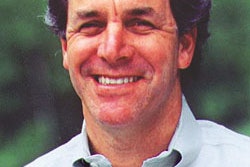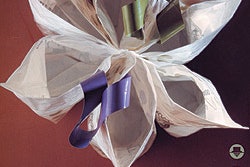When a consumer buys Stonyfield Farm’s yo-gurt, it’s understandable if she or he believes the cup is the package.
But the real “package” includes a liner or overcap, possibly a folding carton, a corrugated shipping case, and stretch wrap.
Then there’s all the machinery necessary to manufacture the various materials, and the equipment to fill, close, case-pack, palletize, and stretch wrap the containers. That consumes energy. Furthermore, oil and gas are needed to deliver pallets of the refrigerated products to the market. Stonyfield Farm analyzes these materials and energy usage to help determine the environmental impact of its packaging.
“We call this our package delivery system, or PDS,” explains Nancy Hirshberg, vice president of natural resources for the Londonderry, NH-based firm.
“The PDS consists of primary and secondary packaging, and the transportation links required to deliver the packaging and products,” she says. It also includes package making and converting.
‘Go (Michigan) Blue’
Since its inception in 1983, Stonyfield Farm has worked to live up to its mission statements, one of which is “to serve as a model [to show] that environmentally and socially responsible businesses can also be profitable.” For years, the company has worked with various organizations and invested money in studies to determine the environmental effects of not just its packaging, but its entire business operation. About two years ago, the yogurt maker hired a consulting firm to evaluate its business to determine where its processes were most detrimental to the environment. What were the results?
“The study slammed us in the face. It determined that our packaging was our single-greatest [environmental detriment],” Hirshberg recalls. “It was clear that we needed to do something to reduce the environmental burden associated with our packaging.”
The results seem somewhat surprising given the company’s efforts to produce “environmentally friendly” packaging. For example, the company has worked to lightweight its yogurt cups and paperboard, incorporated post-consumer board for multipacks, and used natural dyes for printing. But based on the results of that study, the Londonderry firm enlisted the services of the University of Michigan’s Center for Sustainable Systems (Ann Arbor, MI).
The first study was completed last year. That study, Hirshberg explains, “looked at a life-cycle analysis of our packaging, and also helped give us direction on what we can do to try to reduce the environmental burden of our packaging.”
The study compared the company’s current injection-molded polypropylene cups to four alternative systems:
• High-density
polyethylene cups
• Thermoformed cups
• Coated unbleached paperboard cups
• Cups made of corn-based polylactide (PLA)
The Center for Sustainable Systems determined, “no single material stands out as a superior primary packaging material for all container sizes in all burden categories. PP, PLA, and coated unbleached paperboard were shown to be preferable over HDPE for a cup material, and thermoformed cups had lower burdens compared to injection-molded cups.”
One of the more intriguing findings was that the 32-oz containers used less energy than the 8-oz size. Hirshberg says, “It takes more energy for a smaller cup on an ounce-per-ounce basis. The amount of packaging used per unit of product is substantially more for smaller products.” She adds that survey results said “if all Stonyfield Farm yogurt were sold in 32-ounce containers, the annualized energy savings would be equivalent to 11곚 barrels of oil.”
Key recommendations of the study for Stonyfield to evaluate included:
• switching to
thermoformed cup
manufacturing,
• minimizing the shipping distance to retailers by opening a second yogurt production facility,
• optimizing the ratio of primary packaging to corrugated board, and
• continuing to investigate the use of renewable packaging materials.
The study looked at energy consumption, solid-waste production, renewable energy use, air and water use and emissions, and global-warming potential. These were just the environmental criteria.
When determining the overall package, Stonyfield weighs package performance factors such as price, service, strength and stackability, machinability, print quality, ergonomic and safety issues, graphics, consumer acceptance, and vendor environmental practices. These involve inputs from operations and marketing representatives. Consumer input weighs heavily in the decision-making process.
Consumer education
“For one product introduction,” Hirshberg recalls, “it was determined that a specific package option would be the best from both an environmental and cost aspect. But marketing said they had just completed consumer research that determined that consumers wouldn’t buy it. We’d be foolish to introduce a package that consumers wouldn’t buy.”
Stonyfield believes it needs to better educate consumers regarding the environmental impact of its packaging. The company’s use of polypropylene for its cups, for example, has drawn the ire of consumers.
Stonyfield president and chief executive officer Gary Hirshberg, Nancy’s brother, explains: “We receive complaints constantly from people who ask us why we don’t use HDPE for our yogurt cups, because it’s the only type of plastic their town or local recycler accepts.” What they don’t understand is that the PP cups used by Stonyfield are lighter in weight, therefore create a lower environmental burden than HDPE.”
“If you’re just looking at the end-of-life-cycle phase, then the recyclability of HDPE is better for the environment,” says Nancy Hirshberg. “But you have to look at the whole life of that package, from manufacture to consumer disposal. This study did that and found that over the life of the package, PE had more environmental burdens than PP.” Information like this, she believes, shows how Stonyfield Farms has “to do a better job communicating the results of our findings to educate consumers.”
Tried and not true
Stonyfield readily admits that not every effort to deliver “green” packaging succeeds. For example, for a folding carton for multipacks of stick-packed yogurts, the company selected 100% recycled paper, including 35% post-consumer content.
“Our board supplier suggested we not try it,” remembers Steve Inamorati, Stonyfield’s operations control manager. “But we did it anyway.” He says the recycled-content board caused problems in that the print quality wasn’t as good as virgin material.”
However, the main problem with using the recycled-content board, according to Nancy Hirshberg, was its lack of performance in humid environments. “After it went out in the market, our sales people came back to us and said it wasn’t working and that it looked terrible in the stores. The board was sagging, in part because the recycled fibers aren’t quite as strong or as long as are the fibers in virgin board. The recycled board was absorbing too much humidity, even though it went through the refrigerated chain. We especially noticed problems in Florida, so we went back to virgin material immediately.”
In summarizing Stonyfield Farm’s approach to packaging and the environment, Nancy Hirshberg says, “we look at the life-cycle impact of our packaging. We’re learning that the end-of-life aspect of the packaging is only a small part of the equation. It’s upstream where there’s the greatest impact on the environment, and that includes the energy use to make these cups.
“The best thing we can do is to source-reduce and change processes,” she continues. “We’ve dramatically reduced the amount of packaging used on our incoming ingredients, for example, and we continue to evaluate different processes and packages.”
More information on the study is available at the Center for Sustainable Systems’ Web site, http://css.snre.umich.ed, or by calling 734/764-1412.
See sidebar to this article: Yogurt cups to toothbrushes



























